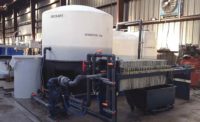During a breakout group at the Stone Summit hosted by UGM Surfaces in Omaha, NE, several months ago, the topic of quartzite arose. With each variety having its unique set of characteristics, experience is a plus when cutting this material. The group, led by Natural Stone Institute President Buddy Ontra of Ontra Stone Concepts in Bridgeport, CT, discussed a host of aspects of working with these exotic materials.
“The first time I ever cut Taj Mahal, I was told it was granite,” said Ontra. “When it arrived at my shop, I thought this doesn’t look like any granite I have ever seen. The customer asked for an ogee edge, so I am pricing it as if I am putting an ogee edge on Santa Cecilia. This was back around 2009. Days had gone by and the guys in my shop are crying because nothing was working. It was chipping and everything else. Since then, I have learned quartzites are unpredictable. The geological structure of this material is different.
“For me, it is all a matter of experience, as to what to expect,” Ontra went on to say. “I tell my customers I have to wait and see when it dries out, when I see one of those absorbent ones. A Taj Mahal or Fusion isn’t going to absorb like others. That’s just what I have learned. Now I am seen as the expert in the area on it. I won’t say, “No, I’m not going to cut that.”
Jennifer Haralson of Zeng Granite, Inc. was among the group participants who weighed in on the subject. “We just started carrying quartzites,” she said. “We talk a lot about what the expectations are with our customers. We talk about the difference in natural stones. I hear the guys in the shop talk. They say it takes longer and slower to cut. You have to give it time to dry out. We can’t promise a three-week turnaround. It’s going to be more like four weeks because you have to give it time to sit.”
“Do your guys know the difference between cutting different quartzites?” Ontra asked. “Because to me, they each cut differently.”
Haralson explained that if the shop’s owner knows one is coming in, he goes in the shop to pass along that knowledge. “We do that with a lot of different things,” she said. “We have a couple types that we sell, but what we run into is there is always someone sending something to us that we never saw before so then we are cutting an edge and playing with it. There are stones that we have written off -- that we won’t do.”
Continuing the conversation, Ontra asked if anyone in the group heard of a soft quartzite. “There is no such thing,” he followed up saying. “But, some of the names like ‘Super White’ is really a dolomitic marble, and is more durable than marble. They call it ‘Shadow Storm,’ ‘Carrara Quartzite.’ These are some names in my area. They are really Brazilian marbles, but they are being called quartzite. My challenge there is that the customer spoke with someone who told them it is a quartzite and then I am telling them it is not.”
A group participant asked Ontra about what kind of information he receives from his suppliers on these stones. “How good are they about labeling these materials?”
“Some are better than others,” said Ontra. “I have nine places within 20 minutes from me. Some are very good at it. They have a little sticker that says ‘Absorption on a one to 10,’ ‘Abrasion on a one to 10,’ ‘Outdoor Use on a one to 10.’ They have done their research and try to educate. They know a designer or homeowner is coming in and then they are coming to me. I am the one taking the money and holding the bag when someone is not happy. So, it is important to ask questions.”




